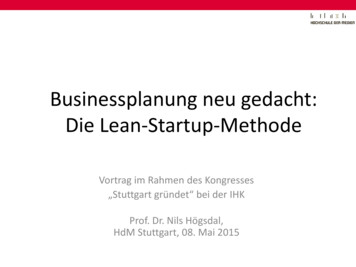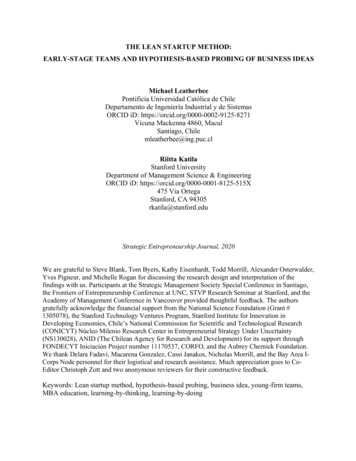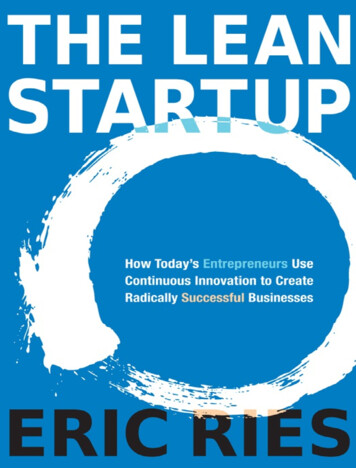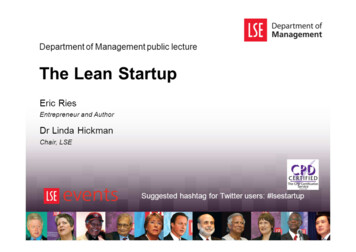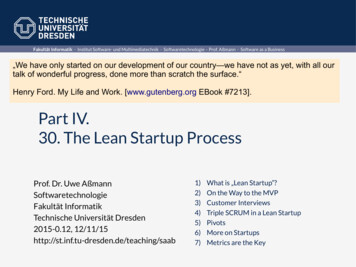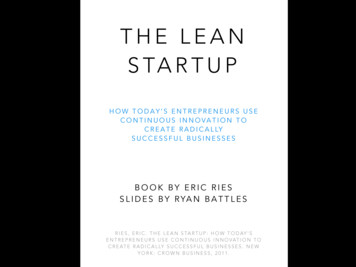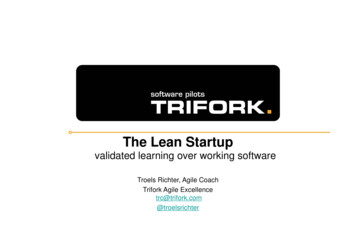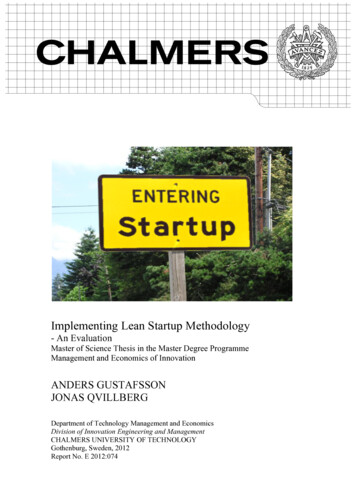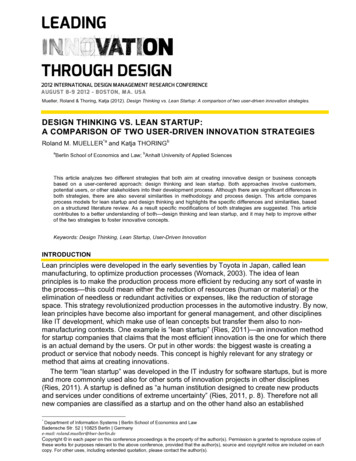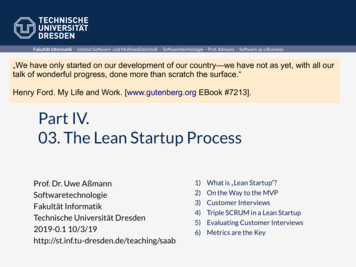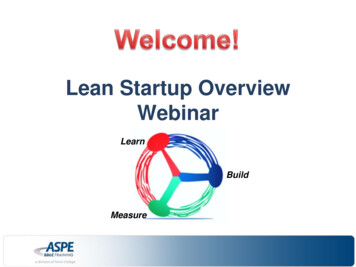
Transcription
Lean Startup OverviewWebinarLearnBuildMeasure
Topics What is Lean Startup? Lean Startup and Traditional Methods Foundations Build-Measure-Learn Loop Pivot or Persevere
Lean Concepts Relentlessly eliminate anything that isn’t adding value Eliminate time spent on what “we know” we’ll need infuture Eliminate inefficient ways of working Optimize the whole system People doing the work know best how to do it Mapping processes and improving WoMBaT: Waste of Money, Brains, and TimeLean Start-Up takes a lean thinking approachto developing new products.Lean.org
What is a Startup? An acutely human enterprise Includes Entrepreneurs andIntrapreneurs Catalyst that transforms ideasinto products Examples:– New Innovation– Scientific discoveries– Repurposing existing technologyfor new use– New business model– Product/Service to new location– Address underserved set ofcustomers– New internal serviceStart-Ups: Human institutiondesigned to create newproducts and services underconditions of extremeuncertaintyEric Ries, The Lean Startup
What is Lean Startup? Application of Lean thinking tothe process of innovation Adapts Lean ideas in contextof entrepreneurship Principled approach to newproduct development Guidance on how to maketrade-off decisions Focused on ValidatedLearning5
Types of Innovation Sustaining Innovation– Improvements to existing product– Serving existing customers– Most companies are good but Disruptive Innovation– Breakthrough new products– New sustainable sources of growth– Companies struggle
Lean Startup OverviewVisionStrategyBusiness PlanAssumptionsGrowthExperimentsProduct IterationsLearningsSustainability?
Why Lean Startup? Traditional approaches tomanagement doesn’t alwayswork with Startups Approach for “continuousinnovation” Start-up success can beengineered with right process Startups must be managed Help recognize when to pivotand when to persevereLean Startup: Set of practicesto help entrepreneurs increasetheir odds of building asuccessful startup.Eric Ries, The Lean Startup
Benefits Business plans, forecasts are difficult to createin totally new product space– Customers can’t tell you what they want becausethey haven’t seen it or conceptualize how they woulduse it– Customers don’t know what they want in advance Customer focused development Get rapid feedback, adapt quickly Strategy based on validated assumptions Understand when to Pivot to reflect learnings Accounting techniques to support the work ofinnovation
What Lean Start-Up Is Not - Not your traditional way tocreate new products Not a collection of individualtactics Not a rigid, lockstep process Not a lack of discipline Not a software developmentmethodology Silver Bullet – Doesn’t fixeverything10
The Stage-Gate Process Alternative to Lean Startup Process containing methods & tools for New ProductDevelopment “Idea to Launch” process, procedures, and controls Breaks process into smaller Stages (containing activities) andGates (Go/Kill decisions) Each Stage gathers more info, reduces risk, raises cost
Stage-Gate vs. Lean StartupStage-GateLean StartupTreats entrepreneurship as managementTreats entrepreneurship as managementRough conceptual productMinimum Viable ProductSpiral DevelopmentBuild-Measure-Learn LoopLaunch is endpointOpen-ended processLimited iterationsEncourages iterationsGo/Kill/Hold/Recycle DecisionsPivot or Persevere DecisionsTraditional Business PlansBusiness Model CanvasStartEndStartEndFinalizing a ProductAchieving SustainabilityHow do we build this?Should we build this?Release a refined final productRelease to test assumptionsRevenue generated with final productMay generate revenue during process
Lean Analytics Stages Are you solving a problem people care about and will pay for? Identify a real problem and real solutionEmpathy Get out of the Building, Interviews, Surveys Will the dogs eat the dog food? Leverage the solution with a small, friendly audienceStickiness Test before going after the massesVirality Will people spread the word? Acquisition, Onboarding processes Force multiplier for paid promotion Will they open their pocketbooks? Monetize Product, Can you make money?Revenue Focus on maximizing and optimizing revenueScale Can we grow the market with sustainability? Acquire customers, expand verticals and geographies Channels, ecosystem, sustainability
Stage Example – Restaurant Owner learns about diners in area Desires, trends, foods not availableEmpathy Gets out of building and talks to diners Develops menu Lots of tests on customers, frequent changesStickiness High costs, variation, uncertain inventory, giveawaysVirality Starts loyalty programs to entice return customers Encourage customers to share with friends, friend coupons Leverages social media Work on margins Fewer free meals, tighter cost controlsRevenue More standardizationScale Proven sustainability Spends on marketing and promotion from revenues, broader advertising Launches second restaurant
Lean Startup Concepts15
Lean Startup Principles1.2.3.4.5.Entrepreneurs are everywhereEntrepreneurship is managementProduct Success depends on learningLeverage Build-Measure-Learn CycleMeasure LearningLean Start-Up is a set of practices to helpentrepreneurs increase their odds of building asuccessful Product.
Lean Startup TenantsTest andLearnQuicklyObserve &MeasureCustomerBehaviorReleaseoften & earlyLeanStartupTenantsFocus onActionableMetricsStay ng
Start-Up ModelProduct OptimizationStrategyVisionPivots
Value and Growth 2 Important Assumptions– Value hypothesis Customers find product valuable Does product or service delivervalue to customer once they useit? Value creating or valuedestroying– Growth hypothesis Reasons behind product’s growth How will new customers discoverproduct?
ProductProblemList top 1-3problemsLean CanvasSolutionOutline possiblesolution foreach problemKey MetricsExistingAlternativesList how theseproblems are solvedtodayList key numbersthat tell how yourbusiness is doingMarketUnique ValueUnfairProposition AdvantageSingle, clear,compellingmessage thatturns unawarevisitor intointerestedprospectHigh-LevelConceptList X for Y analogy(e.g. YouTube Flickr for videos)CustomerSegmentsSomething thatcan’t be easilycopied or boughtList targetcustomers andusers.ChannelsList your pathto customersEarly AdoptersList characteristicsof ideal customersCost StructureRevenue StreamsList fixed and variable costsList sources of revenueAsh Maurya, Running Lean20
Leap-of-Faith Assumptions Strategy is based on assumptions Strategy takes assumptions as agiven and shows how to achieveVision Goal: Test these assumptions assoon as possible Confirm make or break assumptions– Based on reality?– Real problem?
Problem Validation Sniff Test: Friends– If passes Sniff Test, apply theStartup process Interview: ProspectiveCustomers– At least 15– Look for patternsDistracted,Negative BodyLanguage Gut Check: Am I committed tosolving this problem?Want to payyouimmediately
Experiments to Test Strategy Leap-of Faith Assumptions:– Riskiest elements of startup’s plan Identify risks and assumptions beforebuilding anything Test those assumptions experimentally Devise experiments:– Learn to move numbers closer to thoseexpected in business model Products are an experiment,MVP is a processOnce clear of leap-of-faith assumptions,enter Build phase quickly with aMinimum Viable Product (MVP).
Build-Measure-Learn Feedback LoopEric Ries, The Lean Startup
Build Phase Minimum Viable Product (MVP)Fastest full turn of cycleMinimum amount of effortMinimum developmentStart learning as quickly as possible– Any work beyond is waste Answer product design or technicalquestions Challenges traditional notions of quality– MVPs sometimes considered low quality bycustomers Test fundamental hypotheses Usually overestimate needs for MVP– When in doubt, simplify25
MVP - Techniques Concierge MVP–––––Special treatment for first customersTest leap-of-faith assumptionsTremendous learning opportunitiesNot a sustainable modelMay invalidate proposed growth model, changestrategy/pivot– If numbers don’t look promising, problem withstrategy Wizard of Oz– Pay no attention to the people behind thecurtain “Get out of the building”– Go and see for yourself to understand thebusiness problem
Measure Phase Are development efforts leading toreal progress “Metrics are people, too”– Represents breathing, thinking, buyingindividuals– Behavior is measureable andchangeable Are you making your product better? How do you know?
Learn Phase Vital function is learning– Learn truth of what works in strategy– What customers really want (vs. what theysay/think they want)– Are we on the path to a sustainablebusiness? Validated Learning– Demonstrate progress in extremeuncertainty of startups– Demonstrate team discovery of valuabletruths– Antidote to lethal problem of achievingfailure
Validated Learning Demonstrated by positiveimprovements in core metrics Synthesis between vision and whatcustomers will accept Startup Productivity Metric:– Not – How much stuff we built– But – How much validated learning we’regetting Validate Assumptions (hypotheses) Validate Changes
Pivot or Persevere Decisions Does progress show our strategic hypothesis is correct? Do we need to make a major change? Pivot: structured course correction designed to test anew fundamental hypothesis– Product, strategy, growth engine– Keep one foot rooted in learnings so far Persevere: Maintain current path– Misguided decisions to persevere can destroy creative potential– Product neither growing nor dying, consuming resources30
Types of Pivots Zoom-In Pivot: what was single product featurebecomes whole product Zoom-Out Pivot: feature insufficient to supportwhole product, becomes single feature of largerproduct Customer Segment Pivot: Product solvesproblem, not for customer segment originallyplanned Customer Need Pivot: Original problem notreally important, related problems are Platform Pivot: From single application toplatform, vice versa Business Architecture Pivot: high volume/lowmargin vs high margin/low volume
Pivot or Persevere Meeting Pivots require courage, Emotionally charged Signs you need to pivot- Decreasing effectiveness of product experiments- General feeling product development should be moreproductive Address in structured wayPivots become a strategichypothesis– Schedule meeting in advance– Regular meeting, find pace– Business and Product Dev. Teams Content– Product optimization reports– Results against expectations– Accounts of conversations with customers
Intrapreneurs Lean from withinSkunk Works vs McCallum OrganizationsTake risks, uncover non-obvious and unpredictableMust co-exist and integrate with host companyFocus more on “impact” than rate Immune SystemFear of FailureCannibalizes existing businessThreaten employees’ jobsHow things are being doneDisrupts ecosystemInfluence of othersA person within a largecorporation who takes directresponsibility for turning anidea into a profitable finishedproduct through assertiverisk-taking and innovation.- The American Heritage Dictionary
The Startup TeamTeamMemberComm SMEProduct TeamProductOwnerServantLeaders
Role of the Product Owner Leads the Startup as theEntrepreneur Empowered to own product on behalfof the company Responsible for the product success Leads the team by conveying ProductVision to the team Develops and manages the ProductRoadmap Works directly with the developmentteam to facilitate their work Manages Stakeholders needs andexpectations There is only ONE Product Owner35
Summary
Lean Startup OverviewVisionStrategyBusiness ModelAssumptionsGrowthExperimentsProduct IterationsLearningsSustainability?
Summary Lean Startup is a proven framework fordeveloping new products State assumptions explicitly, test rigorously Lean Canvas provides a one-page view ofyour Business Model Race to test the vision, don’t abandon it Accounting takes on a different role in theuncertain world of Startups Don’t fear Pivots Respond to failures/setbacks with honesty andlearning
Thank You!!!I appreciate your time.Robert TysonAgile Coach & Instructor
Lean Startup ReferencesThe Lean Startupby Eric RiesLean Analyticsby Alistair Croll & Benjamin Yoskowitz40
Stage-Gate Lean Startup Treats entrepreneurship as management Treats entrepreneurship as management Rough conceptual product Minimum Viable Product Spiral Development Build-Measure-Learn Loop Launch is endpoint Open-ended process Limited iterations Encourages iterations Go/Kil


